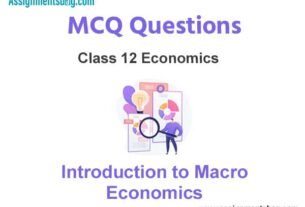Please refer to MCQ Questions Chapter 11 Rebels and The Raj Class 12 History with answers provided below. These multiple-choice questions have been developed based on the latest NCERT book for class 12 History issued for the current academic year. We have provided MCQ Questions for Class 12 History for all chapters on our website. Students should learn the objective based questions for Chapter 11 Rebels and The Raj in Class 12 History provided below to get more marks in exams.
Chapter 11 Rebels and The Raj MCQ Questions
Please refer to the following Chapter 11 Rebels and The Raj MCQ Questions Class 12 History with solutions for all important topics in the chapter.
MCQ Questions Answers for Chapter 11 Rebels and The Raj Class 12 History
Question. “In Memoriam” was dedicated by the artist to the Christian heroism of “British Ladies in India during the Mutiny of 1857. Who was the artist of this famous art?
(A) Henry Lawrence
(B) Thomas Jones Barker
(C) Joseph Noel Paton
(D) Francie Grant
Answer
C
Question. What is the correct meaning of the word ‘’Bell of arms’?

(A) To look through thoroughly in often a rough way
(B) Full of energy and life
(C) sharp or stinging
(D) A storeroom in which weapons are kept
Answer
D
Question. Identify this Governor General.
(A) Governor General Lord William Bentinck
(B) Governor General Henry Hardinge
(C) Governor General Lord Dalhousie
(D) Governor General Warren Hastings
Answer
B
Question. Which one of the following is not correctly match?
(A) Mutiny: A collective disobedience of rules and regulations within the armed forces
(B) Revolt: A rebellion of people against established authority and power. The terms ‘revolt’ and ‘rebellion’ can be used synonymously.
(C) Firangi: A term of Turkish origin, is used in Urdu and Hindi, often in a derogatory sense, to designate foreigners.
(D) Bell of arms: A storeroom in which weapons are kept
Answer
C
Question. Which of the following statement(s) is /are incorrect about Nawab Wajid Ali Shah?
(i) Nawab Wajid Ali Shah was dethroned and exiled to Calcutta on the plea that the region was being misgoverned.
(ii) Wajid Ali Shah was an unpopular ruler.
(iii) When he left his beloved Lucknow, there were many who followed him all the way to Kanpur singing songs of lament.
(iv) The removal of the Nawab led to the unification of the court and its culture.
Identify the incorrect options.
(A) Only (i)
(B) (i) and (ii)
(C) (iii) and (iv)
(D) (ii) and (iv)
Answer
D
ASSERTION AND REASON BASED MCQs :
Question. Assertion (A): There were similarities in the pattern of the revolt in different places.
Reason (R): Sepoys lived in lines and shared a common lifestyle and that many of them came from the same caste
(A) Both A and R are true and R is the correct explanation of A.
(B) Both A and R are true but R is NOT the correct explanation of A.
(C) A is correct but R is wrong.
(D) A is wrong and R is correct.
Answer
A
Question. Assertion (A): To fight the British, leadership and organisation were required
Reason (R): Rumours and prophecies played a part in moving people to action.
(A) Both A and R are true and R is the correct explanation of A.
(B) Both A and R are true but R is NOT the correct explanation of A.
(C) A is correct but R is wrong.
(D) A is wrong and R is correct.
Answer
B
Question. Assertion (A): Ordinary people, peasants began joining the revolt, the targets of attack widened. In major towns like Lucknow, Kanpur and Bareilly, money- lenders and the rich also became the objects of rebel wrath. In most places their houses were looted and destroyed.
Reason (R): Ordinary people not only saw the money-lenders and rich as oppressors but also as allies of the British.
(A) Both A and R are true and R is the correct explanation of A.
(B) Both A and R are true but R is NOT the correct explanation of A.
(C) A is correct but R is wrong.
(D) A is wrong and R is correct.
Answer
A
Question. Assertion (A): In towns and cantonments, sepoys and the common people refused to touch the atta.
Reason (R): There was fear and suspicion that the British wanted to convert Indians to Christianity. Panic spread fast.
(A) Both A and R are true and R is the correct explanation of A.
(B) Both A and R are true but R is NOT the correct explanation of A.
(C) A is correct but R is wrong.
(D) A is wrong and R is correct.
Answer
A
CASE-BASED MCQs :
Question. Read the following excerpt carefully and answer the following questions :
Rumours and prophecies played a part in moving people to action. The Sepoys who had arrived in Delhi from Meerut had told Bahadur Shah about the bullets coated with the fat of cow and pigs and that biting those bullets would corrupt their caste and religion. They were referring to the cartridges of the Enfield Rifles that had just been given to them. The British tried to explain to the Sepoys that this was not the case but the rumour of greased cartridge spread like wild fire across the Sepoy lines of North India.
Question. Why did the Sepoys marched to Delhi from Meerut?
(A) The Governor General of East India company lived in Delhi.
(B) Delhi was the seat and symbol of Mughal authority
(C) Rani Laxmi Bai urged the Sepoys to move to Delhi.
(D) The greased cartridges were being made in Delhi.
Answer
B
Question. How did the rumour of greased cartridges spread like wild fire across the cantonments?
(A) The cantonments were connected through the Telegraph Lines.
(B) The cantonments published their own newspapers, in which this was reported.
(C) This news was broadcasted on the Television.
(D) All of the above
Answer
D
Question. Assertion (A): According to the rumour the cartridges were greased with the fat of cows and pigs.
Reason (R): The Sepoys refused to use these cartridges because for Hindu Sepoys, cow was a revered animal and for the Muslims the pig was a hated animal.
(A) Both A and R are correct and R is the correct explanation of A.
(B) Both A and R are correct but R is not the correct explanation of A.
(C) A is wrong but R is correct.
(D) R is wrong but A is correct.
Answer
A
Question. Consider the following statements :
(a) The greased cartridges were to be used in the new Enfield Rifles.
(b) The British officers tried to explain to the Sepoys that cartridges were not greased. It was just a rumour.
Choose the correct option:
(A) Only (a) is correct
(B) Both (a) and (b) are correct.
(C) Only (b) is correct.
(D) Neither (a) nor (b) is correct
Answer
B



